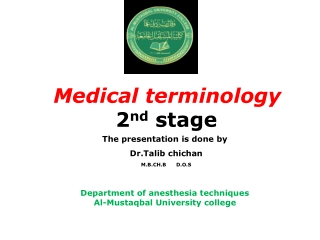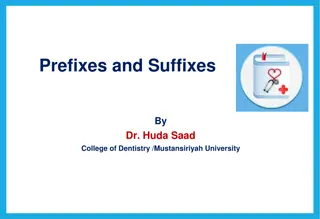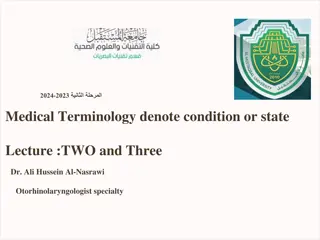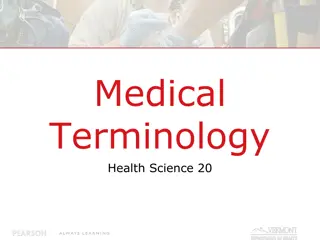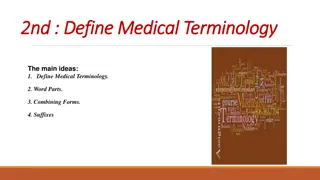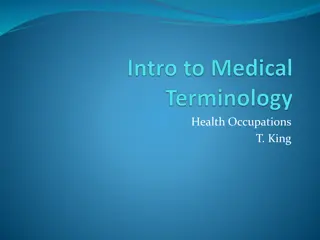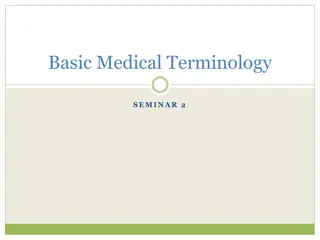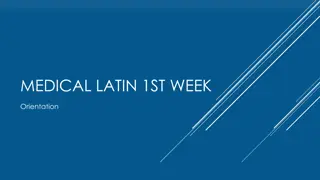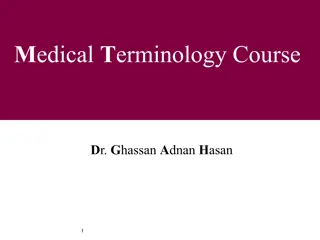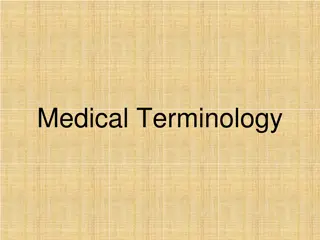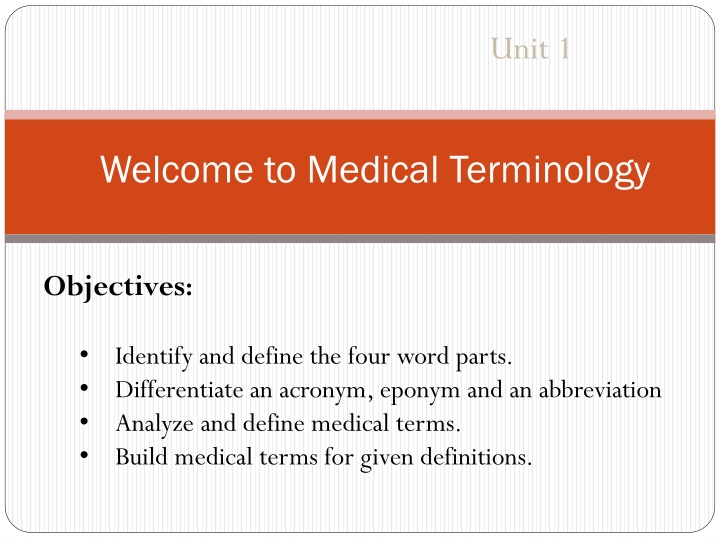
Understanding Medical Terminology: Word Parts, Abbreviations, and Eponyms
Explore the origins of medical language, learn about word parts, differentiate between acronyms, eponyms, and abbreviations, and understand the importance of using proper medical terminology in healthcare settings.
Download Presentation

Please find below an Image/Link to download the presentation.
The content on the website is provided AS IS for your information and personal use only. It may not be sold, licensed, or shared on other websites without obtaining consent from the author. If you encounter any issues during the download, it is possible that the publisher has removed the file from their server.
You are allowed to download the files provided on this website for personal or commercial use, subject to the condition that they are used lawfully. All files are the property of their respective owners.
The content on the website is provided AS IS for your information and personal use only. It may not be sold, licensed, or shared on other websites without obtaining consent from the author.
E N D
Presentation Transcript
Unit 1 Welcome to Medical Terminology Objectives: Identify and define the four word parts. Differentiate an acronym, eponym and an abbreviation Analyze and define medical terms. Build medical terms for given definitions.
Dr. Smith enters the nurses station and tells you that Mrs. Jones needs to have an exploratory laparotomy, but suspects he will end up doing a bilateral salpingoophorectomy. Before she goes to surgery, he orders a CXR, EKG, CBC, and ABG done stat. Mrs. Smith needs what? When? Huh?
Origins of Medical Language Medicine has a language of its own. 75% of all medical terms are derived from Latin or Greek Used to convey the greatest amount of information with the least confusion and the most precision. A Single medical term can describe a disease, condition or procedure that might otherwise take several words. Example: appendectomy surgical removal of the appendix pericarditis inflammation of the sac containing the heart
Abbreviations Shortened forms of words Used in many health fields Each medical facility has an approved abbreviation list It is the responsibility of healthcare workers to learn the meanings of the abbreviations used in the facility in which they work. ***When in doubt, spell it out!! Example: noc (t) night po by mouth
Eponyms Words named after people Examples: Parkinson s disease - is named after James Parkinson, English physician who first described the disease in 1817 as shaking palsy. Lou Gehrig s Disease is named after the famous New York Yankee who suffered from the disease. Down Syndrome is named after John Langdon Down, the British physician who described the syndrome in 1866.
Acronym Short word formed from the 1st letters of the longer phrase Example: SARS (Sever Acute Respiratory Syndrome) LASER (Light Amplification by Stimulated Emission of Radiation) MASH (Mobile Army Surgical Hospital) Can you think of any?
Initialism Formed by the initial letters of a series of words but is pronounced by its letters, not as a word itself Example: ICU (Intensive Care Unit) ESRD (End Stage Renal Disease) ER (Emergency Room) Can you think of any?
With the advancement of medical and scientific knowledge, medical language changes. Some words are discarded, the meanings of others are altered, and new words are added. These terms can be learned by two ways: 1. Memorizing medical terms. (Monotonous ) 2. Learning word parts and how they fit together to form medical terms. (Easier ) *Don t Worry!!! It is impossible to learn all medical terms but knowing the parts will help you figure them out!
Word Parts are the KEY!!! The Four Word Parts Most medical terms are built with some or all of the following word parts: 1. WORD ROOTS 2. SUFFIXES 3. PREFIXES 4. COMBINING FORMS
Word Root the core of the word The word root contains the fundamental meaning of the word. Usually, but not always, indicates the involved body part. Since the word root is the core of the word, each medical term contains one or more word roots. Example: Gastr - stomach
More Examples of Word Roots Play/er; In this word, play is the word root. Arthr/itis; In this medical term, arthr (which means joint) is the word root. Hepat/itis; In this medical term, hepat (which means liver) is the word root.
Suffix The suffix appears at the end of the word root to modify its meaning. Most medical terms have a suffix. The suffix frequently indicates a procedure, condition, or disease such as: scopy, meaning visual examination (procedure) tomy, meaning surgical incision (procedure) -itis, meaning inflammation -oma, meaning tumor (disease) (condition)
Suffix Examples Play/er in this word, -er is the suffix. Hepat/ic in this medical term, -ic (which means pertaining to) is the suffix. Hepat is the word root for liver; therefore hepatic means pertaining to the liver. Hepat/itis in this medical term, -itis (which means inflammation) is the suffix. The term hepatitis means inflammation of the liver.
Prefix The prefix appears at the beginning of a word root and modifies its meaning. Serves to further define a root word Prefixes can indicate; A number such as bi-, meaning two. A position, such as sub-, meaning under. A direction, such as intra-, meaning within. Time, such as brady-, meaning slow Negation, such as a-, meaning without
Prefix Examples Re/play - In this word, re- is the prefix. Sub/hepat/ic - In this medical term, sub- (which means under) is the prefix. What does the term Subhepatic mean? Subhepatic means pertaining to under the liver. Intra/ven/ous - In this word, intra- (which means within) is the prefix. Identify the word root in the medical term Intravenous. The word root is ven, which means vein.
What is the suffix in the word intravenous? The suffix is ous, which means pertaining to. So what does the word intravenous mean? Intravenous means pertaining to within the vein.
Combining Vowel Usually an o. Join the root with a suffix or another root. Used to ease pronunciation so not all terms will have them. Rules for use: 1. used when the suffix begins with a consonant. neur/o + plasty = neuroplasty 2. NOT used when the suffix begins with a vowel. neur/o + -itis = neuritis 3. used when 2 or more root words are joined. gastr/o + enter/o + -itis = gastroenteritis
Examples of Combining Vowels In the word men/o/pause O is the combining vowel used between two word roots In the medical term arthr/o/pathy O is the combining vowel used between the word root arthr and the suffix pathy (which means disease). Why? In the medical term sub/hepat/ic The combining vowel is not used between the prefix sub- and the word root hepat. Why not?
Combining Form A combining form is a word root with the combining vowel attached, separated by a vertical slash. Examples arthr/o oste/o ven/o The combining form is not a word part per se; rather it is the word root and the combining vowel.
Summary Word root- core of a word; for example, hepat Suffix- attached at the end of a word root to modify its meaning; for example, -ic. Prefix- attached at the beginning of a word to modify its meaning; for example, Sub- Combining Vowel- usually an o used between two word roots or a word root and a suffix to ease pronunciation; for example hepat o pathy Combining form- word root plus combining vowel separated by a vertical slash; for example, hepat/o.
Things to Consider Spelling is extremely important! Many word sound the same but have very different meanings Example: ileum is part of the small intestine ilium is part of the pelvic (hip) bone Pronunciation- is also important. Words spelled correctly but pronounced incorrectly may be misunderstood Example: prostate a male gland that lies under the urinary bladder and surrounds the urethra prostrate to collapse and to be lying flat or to be overcome with exhaustion
Pronunciation Accent marks A single accent mark (') is called a primary accent and is used with the syllable that has the strongest stress. A double accent mark (") is called a secondary accent and is given to syllables that are stressed less than primary syllables.
Pronunciation Diacritics are marks placed over or under vowels to indicate the long or short sound of the vowel. Macron ( ) The long sound of the vowel. Breve ( ) The short sound of the vowel. Schwa ( ) Indicates the central vowel sound of most unstressed syllables.
HAPPY MEDICAL TERM BUILDING THE END
The Medical Record The Medical Record May be written on paper or digital Describes information about the pt. and his/her health care Contains the dates, observations, medical or surgical interventions, and treatment outcomes provided during a hospitalization or visit to a health care facility Used to ensure that the pt. receives quality care The actual record belongs to the health care provider, but the information in it belongs to the pt.
The Medical Record The Medical Record Serves as: Basis for planning care and Tx Means for doctors, nurses, and others caring for the pt. to communicate Legal documentation describing the care the pt. received and can be used as evidence in court Means by which the pt. insurance company can verify the services billed were actually provided
The Medical Record The Medical Record May include: Private and confidential information about family relationships, sexual behavior, substance abuse, and even personal thoughts and feelings This is very personal information and is protected by Health Insurance Portability and Accountability Act (HIPAA) in 1996 (more about this Monday!)
The Medical Record The Medical Record The Electronic Health Record (EHR) usually contains the following general components: Patient Data Medical History (Hx) Physical Examination (PE) Consent Form Informed Consent Physician s Orders Nurse s Notes Physician s Progress Notes Consultation Reports Ancillary/Misc. Reports Diagnostic Tests/Laboratory Reports Operative Report Anesthesiology Report Pathology Report Discharge Summary See pgs. 19-20
The Medical Record The Medical Record
The Medical Record https://www.youtube.com/watch?v=Z84fL4HzBmw https://www.youtube.com/watch?v=hcrS13OWQ1U
SOAP: Chart Note Subjective includes symptoms that the subject feels and describes to the health care professional. Not perceptible to the observer. Ex. Dizziness, pain, tightness Objective signs that can be seen, felt, smelled, heard, or measured by the health care provider. Ex. VS such as TPR and BP, physical exam findings such as lung sounds Assessment Interpretation of the subjective and objective findings and generally includes a diagnosis. Planning- includes management and Tx regimen for the pt.

